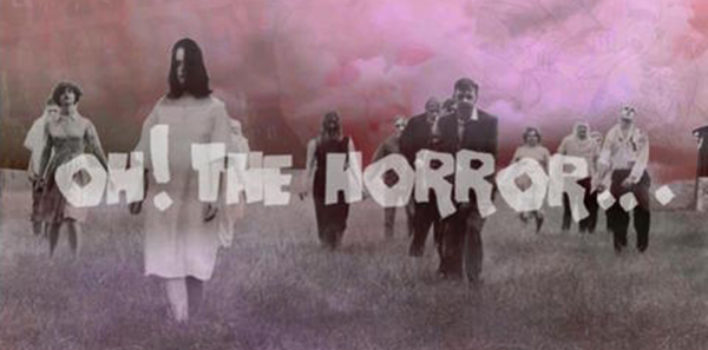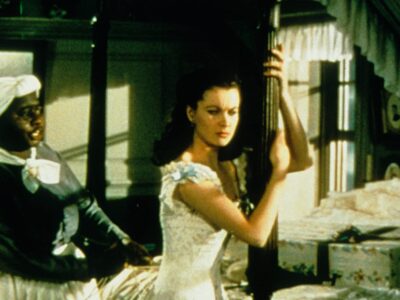Of The 1910s
“Villains!” I shrieked, “dissemble no more! I admit the deed! –tear up the planks! here, here! –It is the beating of his hideous heart!”
–Edgar Allan Poe, “The Tell-Tale Heart”
“In [Thomas] Dixon’s book The Clansman, rape is actual, not implied as in [The Birth of a Nation], with the Black male predator associated with a monster: ‘the black claws of the beast sank into the soft white throat.’ The film was made during a time when a Black man merely looking at a White woman (“eye rape”) resulted in a lynching. The impact of these racist scenes housed in one of America’s most technologically important films is a wicked bell that cannot be unrung. Even today, Black representations draw from those created and popularized by Griffith (and Dixon). Blackness was effectively transmogrified, with Blacks becoming one of the most loathsome and feared of all creatures.”
–Robin R. Means Coleman, Horror Noire: Blacks in American Horror Films from the 1890s to Present
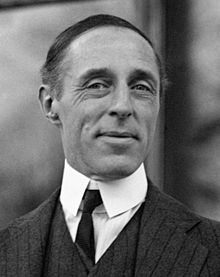 The 1910s were an important decade for American filmmaking. Many changes took place that would lead the United States to primacy in world cinema. While New York City had largely been the home of American films up until 1910, it would quickly shift to the west coast where the weather was finer and filmmakers could escape the patent cases brought against them by the Motion Picture Patents Co. started by Edison. As long as films were being made in the New York/New Jersey region, the chances of their production being closed down were rather high. By 1912, many of the motion picture companies had relocated to Los Angeles, California where Hollywood would be born.
The 1910s were an important decade for American filmmaking. Many changes took place that would lead the United States to primacy in world cinema. While New York City had largely been the home of American films up until 1910, it would quickly shift to the west coast where the weather was finer and filmmakers could escape the patent cases brought against them by the Motion Picture Patents Co. started by Edison. As long as films were being made in the New York/New Jersey region, the chances of their production being closed down were rather high. By 1912, many of the motion picture companies had relocated to Los Angeles, California where Hollywood would be born.
Towards the end of the decade, World War I was in full effect and the ramifications of the Great War were such that Europe’s industries and resources were heavily depleted. This meant that the French and Italian film industries fell by the wayside and the mantle of the leader of world cinema was up for grabs. Before too long, American technology and film industry began to take off even in the midst of the war. By 1920, American cinema had taken the reigns and quickly became the leader in innovation and filmmaking for the world.
It is said that the first full-length motion picture to be shot was released on February of 1915 with D.W. Griffith’s The Birth of a Nation. The original cut of the film ran for just over 3 hours. It was a true silent epic. The story revolved around a white Confederate family and a white Union family during the Civil War and after, during the period of Reconstruction. However, much of the film revolves around the vilifying of freed African Americans who, according to the film, would try to rape White women and wreak havoc on those ‘good and courageous White souls.’ Griffith used novels that traded in white supremacy by Thomas Dixon Jr. to construct the film’s narrative. The Birth of the Nation become one of the most powerful cinematic representations of revisionist history ever to be put on screen. For it was largely because of this film’s technological achievements, that its characterizations of Blackness–performed by white actors in blackface–became stereotypical within American cinema. Many of these characterizations continue to this very day. Don’t believe it? Take a look at the voraciously researched book by Robin R. Means Coleman that is quoted above.
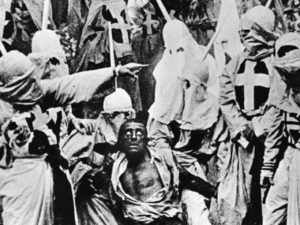 Now, the film we are looking at in this piece is not The Birth of a Nation, but it was directed by the same guy, D.W. Griffith, as well as starring Henry B. Walthall who was also featured in The Birth of a Nation and played Edgar Allan Poe in the 1915 film, The Raven. The Avenging Conscience: or “Thou Shalt Not Kill” was released in March of 1914 and adapted Poe’s “The Tell-Tale Heart” for the big screen. Poe’s brief story about a man who tries to get away with the murder of an old man while he slowly begins to unravel under the burden of his guilt is given the typical Hollywood treatment: love interest, familial tension and negative depictions of minorities considered inferior to whites. The film, though, is not devoid of technique and intrigue. In fact, it is one of the better adaptations of the Poe story put to celluloid. However, the film’s “Italian” character–played by an actor who is clearly not Italian by any stretch–is given short shrift as a drunkard, womanizer and selfish individual who is only out for his own good regardless of the means. This seemed to be a common theme for non-white characters in the films of D.W. Griffith.
Now, the film we are looking at in this piece is not The Birth of a Nation, but it was directed by the same guy, D.W. Griffith, as well as starring Henry B. Walthall who was also featured in The Birth of a Nation and played Edgar Allan Poe in the 1915 film, The Raven. The Avenging Conscience: or “Thou Shalt Not Kill” was released in March of 1914 and adapted Poe’s “The Tell-Tale Heart” for the big screen. Poe’s brief story about a man who tries to get away with the murder of an old man while he slowly begins to unravel under the burden of his guilt is given the typical Hollywood treatment: love interest, familial tension and negative depictions of minorities considered inferior to whites. The film, though, is not devoid of technique and intrigue. In fact, it is one of the better adaptations of the Poe story put to celluloid. However, the film’s “Italian” character–played by an actor who is clearly not Italian by any stretch–is given short shrift as a drunkard, womanizer and selfish individual who is only out for his own good regardless of the means. This seemed to be a common theme for non-white characters in the films of D.W. Griffith.
The basic outline of the film gives flesh to the bare bones narrative of Poe’s terrific short story. A nephew kills his uncle because of his uncle’s unwillingness to allow him a love affair with a fair, young maiden and in order to inherit his uncle’s fortune, but once the deed is done the nephew’s conscience starts to burden him with visions of his ghostly uncle and a religious guilt party to boot. One of the visions even includes the crucified (White) Christ and (White) Moses with his prickly, thorny stones engraved with the ten commandments. Griffith’s imagery spared no bluntness to get the point across: “murder is bad.” It makes Jesus really sad when you kill people. It is in these moments where the film becomes less interesting as film and more interesting as an experiment in linking current day Christian fare like Facing the Giants or God’s Not Dead to the likes of Griffith’s grand morality tales where characters are one-note, good or bad and their change of heart happens with little to no cost.
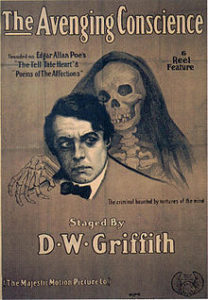 While these moments lack subtlety, the way in which religion is used to scourge the soul of the nephew has a distinct horror flare. Part-human/part-animal entities bowing before an infernal leader, a skeleton bringing its arm around the nephew in a prologue to death and the constant reminder that human action continues to crucify the only truly innocent human who ever walked the earth. These scenes are given all of the passion and power of a million-dollar Jack Chick tract attempting to keep the next generation from becoming a bunch of unrepentant killers.
While these moments lack subtlety, the way in which religion is used to scourge the soul of the nephew has a distinct horror flare. Part-human/part-animal entities bowing before an infernal leader, a skeleton bringing its arm around the nephew in a prologue to death and the constant reminder that human action continues to crucify the only truly innocent human who ever walked the earth. These scenes are given all of the passion and power of a million-dollar Jack Chick tract attempting to keep the next generation from becoming a bunch of unrepentant killers.
Perhaps the most intriguing aspect of the film lies in the moments when the nephew begins to put together his plan to murder his uncle. A title card pops up that speaks of Nature as “one long system of murder. Ants, flies and spiders.” The nephew takes inspiration from the ants on the ground who are devouring a dead earthworm and a spider who wraps up flies in its web in order to dissolve and eat liquified fly bodies. The nephew is inspired by the normal violence in nature to kill his uncle. Man learning to be red in tooth and claw.
The nephew’s focus on nature’s deconstruction of itself is representative of the death sentence humanity handed down to it. In one sense, the nephew is gaining inspiration from a state of being that his own species caused. In another sense, it is a reminder that things are not as they should be, not in Nature, not in humanity, not in the structures that humanity creates, etc. It is all on a slow decline towards death.
This all seems kind of fatalistic right? If left to the observable brokenness of Nature and of human society, then, yes, there is not much hope. For all the progress we make in human history, we are saddled, also, with a regression that we can’t ultimately help. It’s intrinsic to our being. Our selfish need to be gods will always get in the way of what is good for the flourishing of all people. Our selfish need to create insular groups always gets in the way of loving those that are not like us. And that selfishness leads to natural decay of being…or decay at the hands of others like the earthworm being eaten by the ants or the fly being dissolved by the spider.
 When the nephew strangles his uncle, he is making himself a judge, juror and god over another person. He looks upon the visage of his uncle and declares him to be wanting within the moral laws he, himself, has constructed. As Poe writes in “The Tell-Tale Heart,” the guilty conscience has a way of cutting through the nonsense of human laws and convicting the heart. The remainder of the film is a fever dream of paranoia as the police begin to swarm him and his life and sanity begins to depart. The nephew finally gives in to the burden of his conscience. The conscience that knows the Lord’s goodness if one has ears to hear it. He is an avenging God and His mark of conscience is effective.
When the nephew strangles his uncle, he is making himself a judge, juror and god over another person. He looks upon the visage of his uncle and declares him to be wanting within the moral laws he, himself, has constructed. As Poe writes in “The Tell-Tale Heart,” the guilty conscience has a way of cutting through the nonsense of human laws and convicting the heart. The remainder of the film is a fever dream of paranoia as the police begin to swarm him and his life and sanity begins to depart. The nephew finally gives in to the burden of his conscience. The conscience that knows the Lord’s goodness if one has ears to hear it. He is an avenging God and His mark of conscience is effective.
However, in early Hollywood style, the story needs a happy resolution and The Avenging Conscience is no different. The nephew wakes from a dream to find his uncle still alive and his lover still in love with him and his criminality a mere flick of the subconscious brain. He only premeditated the murder of his uncle. He’s not that bad after all.
“You have heard that it was said to those of old, ‘You shall not murder, and whoever murders will be in danger of the judgment.’ But I say to you that whoever is angry with his brother without a cause shall be in danger of the judgment.” (Matt. 5:21-22b, NKJV).
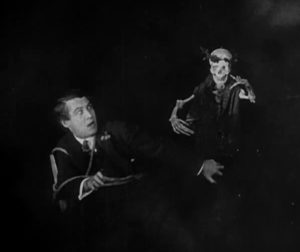 Yet an older command comes forth from the depths of man’s memory. Jesus states that one’s anger without cause is the same as murdering someone. The whole fever dream of the nephew’s was a premeditation of murder because of anger over his uncle’s dislike of his lover. He committed murder in his heart and that is just as serious within the ethics of Jesus.
Yet an older command comes forth from the depths of man’s memory. Jesus states that one’s anger without cause is the same as murdering someone. The whole fever dream of the nephew’s was a premeditation of murder because of anger over his uncle’s dislike of his lover. He committed murder in his heart and that is just as serious within the ethics of Jesus.
Just like the man behind the camera who was so blinded by his hatred and anger towards black people that he made the film by which all other films followed suit in their negative portrayals of Blackness. He can say he never “hurt” an African American, but, like, the nephew, the heart often proves otherwise and Jesus will have none of it.
Conscience is led by the God of the universe, He is just and good. He will avenge those who are made low and His presence will be known on the earth and in the heavens. With that kind of power, it’s no wonder that the burden and shame of our sin weighs down heavy upon our necks. Yet the point where the futility ends is at the foot of the cross where guilt and shame are nailed to the cross. Even a rabid racist like Griffith had hope, but, let us not forget that while he may have been saved by the blood, that sin still comes with consequences on earth and judgment before the Lord on that not so distant day. Justice is mine, sayeth the Lord.


